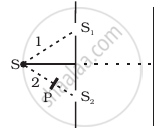Advertisements
Advertisements
प्रश्न
Unpolarised light is incident on a polaroid. How would the intensity of transmitted light change when the polaroid is rotated?
उत्तर
If the unpolarised light is incident on a Polaroid the intensity is reduced by half. Even if the Polaroid is rotated by angle θ the average over cos2θ = ½. Thus from Malus’ law: I = I0cos2θ
Or, = < I0cos2θ > = I0< cos2θ > = I0/2
Thus, the intensity of the transmitted light remains unchanged when the Polaroid is rotated.
APPEARS IN
संबंधित प्रश्न
If the critical angle of a medium is sin-1(3/5), find the polarising angle.
Show, with the help of a diagram, how unpolarised sunlight gets polarised due to scattering.
Two polaroids P1 and P2 are placed with their pass axes perpendicular to each other. Unpolarised light of intensity I0 is incident on P1. A third polaroid P3 is kept in between P1 and P2 such that its pass axis makes an angle of 60° with that of P1. Determine the intensity of light transmitted through P1, P2 and P3.
Show using a proper diagram how unpolarised light can be linearly polarised by reflection from a transparent glass surface.
With the help of an experiment, state how will you identify whether a given beam of light is polarised or unpolarized?
A ray of light is incident on a transparent medium at a polarizing angle. What is the angle between the reflected ray and the refracted ray?
What is the difference between polarised light and unpolarised light?
A ray of ordinary light is travelling in air. It is incident on air glass pair at a polarising angle of 56°. Find the angle of refraction in glass.
State and obtain Malus’ law.
Figure shown a two slit arrangement with a source which emits unpolarised light. P is a polariser with axis whose direction is not given. If I0 is the intensity of the principal maxima when no polariser is present, calculate in the present case, the intensity of the principal maxima as well as of the first minima.

